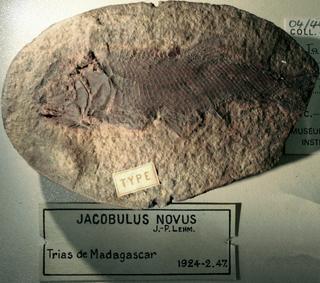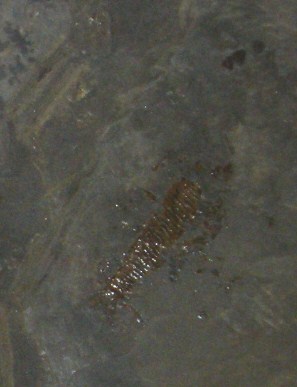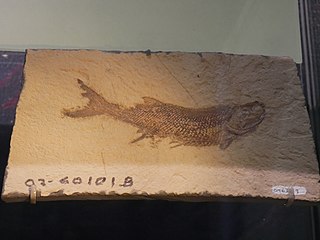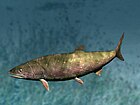Batrachosaurus is an extinct genus of prehistoric brachyopoid amphibian that lived in Germany during the Middle Triassic (Ladinian). The genus was named by Joseph Fitzinger in 1837 and the type species, B. jaegeri, was named three years later in 1840. It may have been the same animal as Mastodonsaurus.

Jacobulus is an extinct genus of prehistoric ray-finned fish that lived during the Early Triassic epoch in what is now northern Madagascar 252.3 to 251.3 million years ago. The type species is Jacobulus novus (monotypy). It was a small fish less than 10 centimetres (3.9 in) in length. J. novus ecology was a grazer-detritivore. It belongs to the Parasemionotidae together with Albertonia, Candelarialepis, Icarealcyon, Lehmanotus, Parasemionotus, Qingshania, Stensioenotus, Suius, Thomasinotus, and Watsonulus.

Pteronisculus is an extinct genus of prehistoric ray-finned fish that lived during the Early Triassic and Middle Triassic epochs of the Triassic period.
Luganoia is an extinct genus of prehistoric bony fish that lived during the early Ladinian stage of the Middle Triassic epoch.

Habroichthys is an extinct genus of prehistoric bony fish that lived during the early Ladinian stage of the Middle Triassic epoch, 242 to 232 million years ago. It has been found in Austria, China, Italy, Slovenia, and Switzerland. It was a small fish measuring 26 cm (10 in) long.
Gosfordia is an extinct genus of prehistoric lungfish known from the Triassic of Australia.

Heptanema is an extinct genus of prehistoric coelacanth from the Middle Triassic (Ladinian) of northern Italy and Switzerland.
Metaceratodus is an extinct genus of prehistoric lungfish in the family Ceratodontidae, with an indeterminate specimen known from the Late Triassic (Norian)-aged Lissauer Breccia of Poland and more complete specimens known from the Late Cretaceous of Queensland, Australia and Argentina. The genus was named and described by Frederick Chapman in 1914.

Paraceratodus is an extinct genus of prehistoric lungfish. Only one species, P. germaini, is known from the latest Permian or earliest Triassic period of Madagascar. Phylogenetic evidence supports it being the most basal member of the suborder Ceratodontoidei, which contains modern lungfish, and as with the rest of the order it likely diverged during the late Carboniferous.
Tranodis is an extinct genus of prehistoric sarcopterygians or lobe-finned fish. It was a lungfish from the Upper Mississippian of North America.
Acentrophorus is an extinct genus of prehistoric ray-finned fish from the Permian and Triassic periods. Fossils have been found in Australia, Germany and the United Kingdom. It was the oldest known neopterygian.

Bobasatrania is an extinct genus of prehistoric bony fish that survived the Permian-Triassic extinction event. Fossils of Bobasatrania were found in beds of Changhsingian to Ladinian age. It was most speciose during the Early Triassic. The genus was named after the locality Bobasatrana in northeast Madagascar, from where the type species was described.

Boreosomus is an extinct genus of Triassic ray-finned fish. It was first described from the Arctic island of Spitsbergen, but was later also discovered in other parts of the world. Boreosomus belongs to the family Ptycholepidae. Other genera of this family are Acrorhabdus (Spitsbergen), Ardoreosomus, Chungkingichthys (China), Ptycholepis (global) and Yuchoulepis (China).

Brembodus is an extinct pycnodontid, the type genus of the family Brembodontidae. G. cenensis fossils are known from the Late Triassic strata of Cene, Italy.

Cyranorhis is an extinct genus of prehistoric bony fish from the Carboniferous period.
Serrolepis is an extinct genus of prehistoric bony fish. It was a highly specialized small stem-neopterygian with strong jaws and a short head. Body shape is variable and known material appears to fall within several size classes & two morphotypes. Fossils of Serrolepis are known from the Middle Triassic Erfurt Formation of Germany.

Gyrolepis is an extinct genus of prehistoric ray-finned fish from the Middle-Late Triassic epochs in what is now Europe. It is known both from complete specimens and isolated skeletal elements, such as scales or teeth.

Hemicalypterus is an extinct genus of prehistoric ray-finned fish that lived during the late Triassic period. It contains a single species, Hemicalypterus weiri. Fossils have been collected in the southwestern United States, including Utah and New Mexico. Hemicalypterus belonged to the family Dapediidae, and like other members of its family, it was a deep-bodied fish with a covering of thick ganoid scales. It differed from other dapediids in lacking scales on the posterior part of the body, and in possessing unusual, multicuspid teeth. These teeth were similar to those of modern-day herbivorous fish, which indicates that Hemicalypterus may have been a herbivore as well.
Platysiagum is an extinct genus of prehistoric bony fish belonging to the family Platysiagidae. Fossils are known from the Middle Triassic of China and Italy and the Early Jurassic of England.
Turseodus is an extinct genus of ray-finned fish found in Late Triassic freshwater sediments of the United States. Two species have been described, T. acutus from the Lockatong Formation of Pennsylvania, and T. dolorensis from the Chinle Formation of Colorado.












